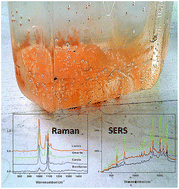Biogeochemical specificity of adjacent natural carbonated spring waters from Swiss Alps promptly revealed by SERS and Raman technology
Abstract
The inorganic salt content and microbiological properties of the mineral waters from the old and famous springs of Tarasp in the lower Engadin Valley of the Swiss Alps have been simultaneously assessed using silver nanoparticles and the surface enhanced Raman scattering (SERS) technique in conjunction with normal Raman scattering. The raw mineral waters collected from four distinct, adjacent natural springs and their corresponding salts revealed significant differences related to different anion contents and microorganism signatures. The total solid material recovered after water evaporation at room temperature revealed the Raman spectroscopic characteristic of the carbonate and sulfate anions, where the balance between them was variable from one spring to another. The extinction spectra of the spring water – silver nanoparticles (AgNPs) mixtures emphasized a time dependent aggregation of AgNPs while their SERS signal unambiguously revealed an adsorbed beta-carotene spectral signature, related to the different cyanobacteria content of carbonated springs.


 Please wait while we load your content...
Please wait while we load your content...